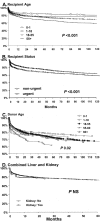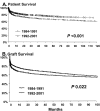Analysis of long-term outcomes of 3200 liver transplantations over two decades: a single-center experience
- PMID: 15912040
- PMCID: PMC1357170
- DOI: 10.1097/01.sla.0000164077.77912.98
Analysis of long-term outcomes of 3200 liver transplantations over two decades: a single-center experience
Abstract
Objective: Few studies have evaluated long-term outcomes after orthotopic liver transplantation (OLT). This work analyzes the experience of nearly 2 decades by the same team in a single center. Outcomes of OLT and factors affecting survival were analyzed.
Methods: Retrospective analysis of 3200 consecutive OLTs that were performed at our institution, between February 1984 and December 31, 2001.
Results: Of 2662 recipients, 578 (21.7%) and 659 (24.7%) were pediatric and urgent patients, respectively. Overall 1-, 5-, 10-, and 15-year patient and graft survival estimates were 81%, 72%, 68%, 64% and 73%, 64%, 59%, 55%, respectively. Patient survival significantly improved in the second (1992-2001) versus the era I (1984-1991) of transplantation (P < 0.001). Similarly, graft survival was better in the era II of transplantation (P < 0.02). However, biliary and infectious complications increased in era II. When OLT indications were considered, best recipient survival was obtained in children with biliary atresia (82%, 79%, and 78% at 1, 5, and 10 years, respectively), while malignant disease in adult patients resulted in the worst outcomes of 68% and 43% at 1 and 5 years, post-OLT. Further, patients <18 years and nonurgent recipients exhibited superior survival when compared with recipients >18 years (P < 0.001) or urgent patients (P < 0.001). Of 13 donor and recipient variables, era of OLT, recipient age, urgent status, donor age, donor length of hospital stay, etiology of liver disease, retransplantation, warm and cold ischemia, but not graft type (whole, split, living-donor), significantly impacted patient survival.
Conclusions: Long-term benefits of OLT are greatest in pediatric and nonurgent patients. Multiple factors involving the recipient, etiology of liver disease, donor characteristics, operative variables, and surgical experience influence long-term survival outcomes. By balancing and matching these factors with a given recipient, optimum results can be achieved.
Figures






References
-
- Cannon JA. Brief report. Transplant Bull. 1956;3:7.
-
- Rolles K, Williams R, Neuberger J, et al. The Cambridge and King's College Hospital experience of liver transplantation, 1968–1983. Hepatology. 1984;4(suppl 1):50–55. - PubMed
-
- Fonkalsrud EW, Stevens GH, Joseph WL, et al. Orthotopic liver allotransplantation using an internal vascular shunt. Surg Gynecol Obstet. 1968;127:1051–1057. - PubMed
-
- Pichlmayr R, Brolsch C, Neuhaus P, et al. Report on 68 human orthotopic liver transplantions with special reference to rejection phenomena. Transpl Proc. 1983;15:1279–1283.
Publication types
MeSH terms
LinkOut - more resources
Full Text Sources
Medical

